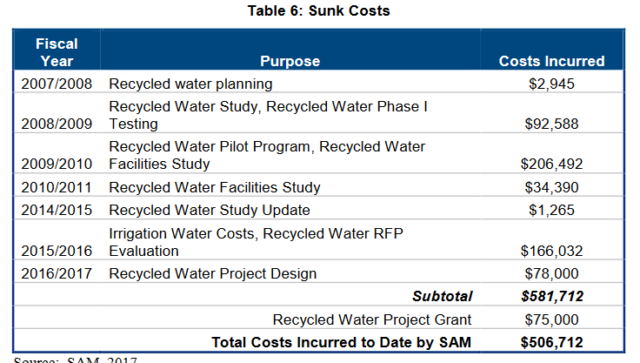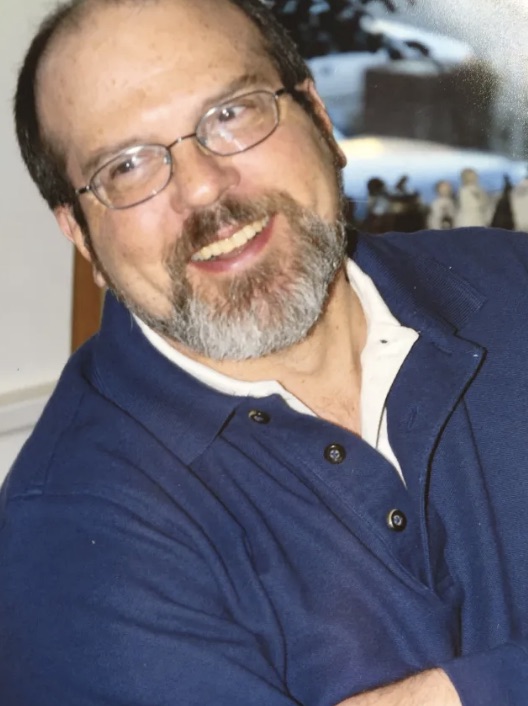|
Getting your Trinity Audio player ready...
|
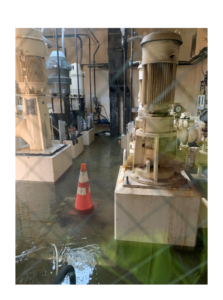
OWN VOICE. ~ InPerspective by Gregg Dieguez —
The goal of this article is to alert the MidCoast public to the near disaster at our sewer Authority Midcoast (SAM) plant, the causes thereof, and the actions needed to prevent a failure that would disable sewage treatment for an extended period of time. The article makes controversial [1] suggestions because they conflict with both real estate profiteering and the current unfounded lawsuit by HMB against its partner agencies in SAM.
Footnotes: to use, click the bracketed number and then click your browser Back button to return to the text where you were reading.
Images: Click to enlarge for improved readability in a new window.
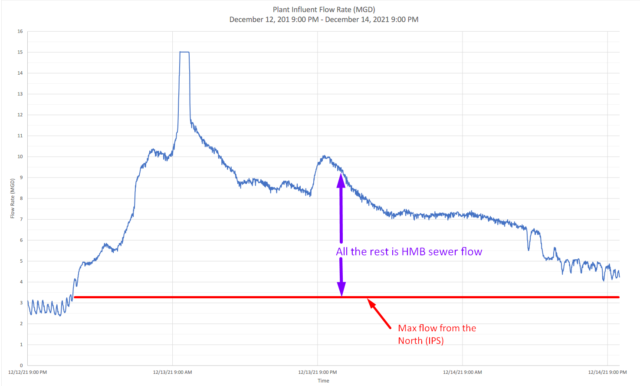
What happened?
The recent rainstorms of about Oct. 25th, Dec. 13th, and Dec. 22nd, 2021 have highlighted the inadequacy of current sewer systems on the coast of San Mateo County. Pacifica had a 3 million gallon spill during the storm of Oct. 25-27th, in spite of adding storm drainage capacity a while back. At SAM, thanks to timely expansion in 2021 of the wet weather storage (WWS) in El Granada, we avoided such a spill – by 6 inches at the Burnham Strip Wet Weather Storage Facility. [Which is part of the Inter-tie Pipeline System (IPS) designed into the SAM system, and the subject of HMB’s lawsuit against its partner agencies, as described further in the link.] During these storms SAM was, thrice again, able to hold back flows from the north in the IPS, as long ago designed and repeatedly utilized, thus preventing the plant from being overloaded and damaged. The storm on December 13th, however, did overload the SAM wastewater treatment plant (WWTP), even with the extra WWS in the IPS. At the plant, flows exceeded a daily rate of 15 million gals/day for almost an hour, which exceeded the maximum design capacity of the plant’s input.[2] Only by using a portable pump to siphon off the excess inflows from the headworks and pump them directly into downstream SAM processing was SAM able to avoid another spill. However, there was a small spill in Montara, which might have been averted had the necessary equipment not been in use at SAM dealing with the potentially greater threat.
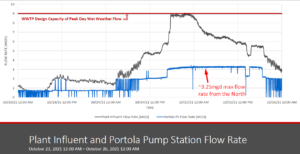
As is seen in the graph << at left, the IPS maximum flow rate is a little over 3 mgd. That flow rate was achieved during these storms. The greater problem is shown in the graph at right above ^^. At the WWTP, flows on Dec. 13th exceeded the ability of the instruments to measure them, which had been calibrated for a maximum flow of 15mgd. The most the flows from the northern agencies via the IPS could have been is shown by the horizontal red line at 3.25mgd. All the rest of those flows came from HMB’s sewer collection system. At the peak of the storm, approximately 80% of the plant’s flows were from HMB.
Those peak flows caused flooding in the effluent building at SAM (picture at top), and flooding could have gone further, down to the electrical building, and shorted out the control systems for the plant, shutting it down. The SAM GM presentation on these events, from which some of these images were drawn, can be viewed here. See the references below for more information about the vulnerability of the plant’s electrical systems.[3]
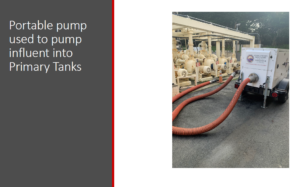
In addition, there was a small spill at the Montara Date-Harte pump station during the Dec. 13th storm. A pump failed. The SAM staff and equipment that (under the current service contract) might have averted that spill were instead occupied preventing a more major disaster at the SAM WWTP. The Montara Impact, in round numbers: $140k for emergency coping actions, plus an unknown amount in fines; $150k more funding now to prevent another spill in the event of a similar storm, and ~$1 million later to design and equip a permanent solution.[4]
What Do We Do Now?
We have thus exceeded the theoretical design capacity of the SAM plant. Currently, HMB has no WWS of its own. This issue has been raised by prior SAM GM’s, one of whom suggested years ago that WWS be created underground at the Ocean View Driving Range (thus allowing the surface use to continue). The location is HMB’s to decide, but the need is acute and immediate. The amount of such storage can best be sized by a national consulting firm such as Brown & Caldwell, who has assisted SAM in dealing with excess pollutants recently. On a simple ratio basis, with 834,000 gals of WWS upstream, and more capacity in the IPS pipes themselves, the IPS can hold about 1 million gallons of untreated sewage. HMB has risen to 60% of normal monthly SAM flows. On a simple ratio basis it would thus appear HMB should have 1.5 million gallons of WWS to be in parity with the northern agencies. However, when one considers instead the PEAK flows, the IPS only supplies a maximum of about 3 million gallons/day at peak flow rate. Thus approximately 12 mgals/day of that unmeasurable peak flow on Dec. 13th came from HMB sewers this past storm. Using that ratio (80%), HMB would need to provide over 4 million galllons of WWS to be on a par with the northern agencies.
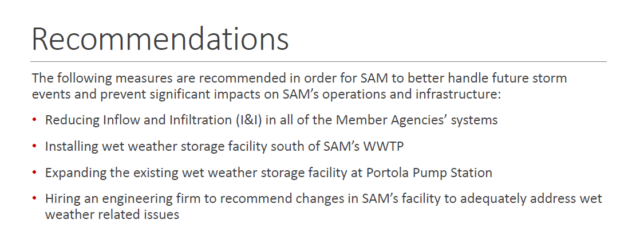 The SAM staff recommendations to the Board are shown at right. >> The polite wording is installing a WWS facility “south of SAM’s WWTP”. That means: Half Moon Bay. The other recommendations are worthy as well. The I&I of water into sewer pipes is a longstanding problem, but a complete cure would involve sealing every manhole cover, relining or sealing every sewer lateral and pipe in a collection system, and finding and stopping people who direct storm water (e.g. off a home roof) into sewers to protect their property from flooding. The cost of that is tens to hundreds of millions of dollars, and the time to take effect is MUCH longer than additional WWS, which can be done immediately. The addition of more WWS on the Burnham Strip makes sense. In fact, I recommended it when the recent WWS expansion was considered, but the HMB Board members – already only agreeing to fund WWS under protest because of the outstanding lawsuit – declined that option. We can now add it, again, at greater cost than had we done it right the first time, but as was pointed out by GCSD in the meeting, we have to hurry up before GCSD completes a planned recreational project atop that land in 2 years.
The SAM staff recommendations to the Board are shown at right. >> The polite wording is installing a WWS facility “south of SAM’s WWTP”. That means: Half Moon Bay. The other recommendations are worthy as well. The I&I of water into sewer pipes is a longstanding problem, but a complete cure would involve sealing every manhole cover, relining or sealing every sewer lateral and pipe in a collection system, and finding and stopping people who direct storm water (e.g. off a home roof) into sewers to protect their property from flooding. The cost of that is tens to hundreds of millions of dollars, and the time to take effect is MUCH longer than additional WWS, which can be done immediately. The addition of more WWS on the Burnham Strip makes sense. In fact, I recommended it when the recent WWS expansion was considered, but the HMB Board members – already only agreeing to fund WWS under protest because of the outstanding lawsuit – declined that option. We can now add it, again, at greater cost than had we done it right the first time, but as was pointed out by GCSD in the meeting, we have to hurry up before GCSD completes a planned recreational project atop that land in 2 years.
The SAM Board discussed a number of other alternatives and processes moving forward. Those included:
- Hire consultant to create a Request For Proposal (RFP) to define alternatives for both short term and longer term fixes.
- Review prior improvements recommended by the consultant to SAM, Dan Childs, in prior years
- Review and act on the 2013 WWTP electrical reliability study
- The treatment plant is affected by rising groundwater; divert or store
- “Recycling atmospheric rivers” – include MWSD and CCWD water districts in the conversation
- Capture storm runoff; recharging groundwater basins
- Decentralized sewage treatment and storage facilities
- Add another 200kgal WWS in El Granada
- Look for longer term repositioning of SAM (10-15 year project)
- Recalibrate the flow and depth instruments to handle the new maximum flows.
However, there are things that can be done, and there are things that can be done FAST. Two things should happen, immediately, and neither of them were mentioned in the discussion following the GM presentation:[5]
First, HMB needs to add WWS capacity in its sewer collection system before the next winter (or ASAP). The amount of such storage can best be sized by a national consultancy such as Brown & Caldwell or HDR. My simple estimates are above. Second, all SAM-related agencies must immediately cease all new water and sewer connections. For HMB, this will mean no new hotel. For all agencies this must mean no ADU’s, and no population expansions of any kind until the sewer system is properly sized and paid for by the forces that have pushed our sewers past a tipping point and beyond capacity. We need to stop adding to the problem, until we fix the problem. We are putting our ratepayers and our environment at risk by delaying these simple actions. Of course, state housing mandates and other forces will resist this, but I oppose putting even greater risks (spills and fines) and costs on existing residents and ratepayers who do not profit from growth.
As to the rest of those thoughts on alternatives: “Hiring a consultant to write an RFP to get consultants to design solutions to be bid and then built…” well, you can see we’re a year plus away from actually starting anything if we only wander down that path. Such a study should be done, unless it already has been done, and that’s where items 2 and 3 make sense. In particular, a quick fix to some of the electrical building vulnerability is to waterproof seal the foundation, inside and out of that building, add a small, sloped concrete skirt (also sealed) around the perimeter to prevent water from pooling around the building, and raise the threshold of all doors (as they do on ships and submarines). Some removable ramps can be built to allow movement of equipment and and out, and perhaps the height of the doors would also need to be altered. That type of weatherproofing should suffice for the next few years, while the very valid longer term analyses are conducted.
Item 4, water table rise, is worth study, and overlaps with item 9, relocating the plant. Item 6, stormwater, may make sense in some jurisdictions, but storm runoff isn’t the problem at SAM – excess sewer flows are. Item 7 leads to consideration of Package Plants and other new treatment approaches, and belongs in the evaluation with item 9. Item 8 is annoying, because HMB delayed and downsized the latest WWS upgrade, but if it must be done, it must be done. Item 3, redesign of the electrical building and systems, might be a medium term requirement or it might await the longer term redesign of the entire SAM facility – that is worth discussion. Item 5, Recycling, makes no sense as a solution for excess sewer flows, because you have to treat the water before you recycle it, and the immediate problem is TOO MUCH WATER to treat. Recycling is also a sore point because the northern agencies had co-funded a $500k study of recycling (with no prospective benefits to those agencies, but because it was the Right Thing To Do), and SAM was about to put a recycling program out to bid, two weeks before HMB sued.[6] Still, recycling and recharging aquifers is a widely considered alternative, and our region faces 59% water cutbacks in drought years. It must be considered, along with the issue of what stakeholders need, and will perpetually pay for, that expensive water supply.
Clearly a combination of growth and climate change has pushed our sewer infrastructure past capacity. Sorting out who should pay for what will take just a long as figuring out the correct solutions. I suspect existing residents do not want to pay for capacity that allows new joiners to further add risk to the system, while burdening the 99% – the current residents – so that the 1% – the new joiners and their investors – can profit.
Had HMB not pursued the lawsuit against its agency partners, the $1 million (and counting) spent on attorneys for the illegitimate lawsuit would have gone a long way to paying for the necessary WWS in HMB. The WWS in the IPS has, thrice again, saved HMB and our system from even greater damage. It’s time for HMB to step up, add wet weather sewer storage, and become a responsible partner in our mutual sewer authority.
FOOTNOTES & REFERENCES:
[1] Controversy:
I can gather that my comments are controversial, because when I authored a Letter to the Editor on this same topic in the HMB Review, it took them a full week to publish it, and when they did, the letter had been surgically edited to drop this sentence: “The WWS in the IPS has, twice again, saved HMB and our system from even greater damage.” One wonders who advised whom to drop that one item? Could it have been because that observation contradicts the claims HMB is presenting in their lawsuit?
[2] Details on SAM Wastewater Treatment Plant Design Capacity:
from SAM 1/10/22 Presentation on the major storms:
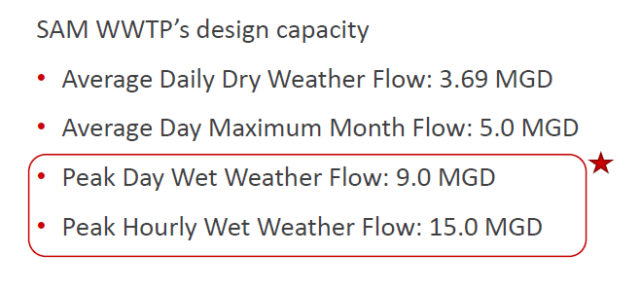
[3] 2013 report on SAM Electrical plant vulnerability:
(full report at this link)
“In summary, the component design and configuration of Switchgear MD and the locations of the utility and backup power sources present a significant risk to SAM. Failure of this equipment could result in flooding of the WWTP, significant disruption or failure of the treatment process, and extended water quality violations.”
[4] MWSD report on Date/Harte Spill 1/6/22:
MWSD Staff Report – click to read
Key Point in MWSD 1/6/22 Board video discussion of SAM’s impact on MWSD Date – Harte Sewer Pump Station spill:
https://youtu.be/WPtY1AB3Hrw?list=PLFUunuheJ0ZV9aPr4s8iSJWJxoqMEYO5d&t=2320
“If SAM would have responded with the appropriate equipment, I think the spill could have been prevented.”
(the full discussion of this new business item 2 starts at 19:10)
(Dispute about accuracy of SAM report on this spill: 27:00)
[5] Suggestions from SAM board during discussion 1/10/22:
https://videoplayer.telvue.com/player/wuZKb9gwEY7sMACIIsr7VSJglB35kNZA/media/693214?autostart=true&fullscreen=false&showtabssearch=false&jwsource=cl
at about 55:00 mins of that video, Board discusses the implications of the SAM report:
– hire consultant to create RFP for both short term and longer term fixes.
– review prior improvements recommended by consultant Dan Childs in prior years
– review 2013 WWTP electrical reliability study – affected by rising groundwater
– “Recycling atmospheric rivers” – include MWSD and CCWD in the conversation (Penrose)
– capturing runoff; recharging groundwater basins – pointed to Pilarcitos Creek/flood storage basins (Stone Pine ?)
– decentralized treatment and storage facilities (Slater-Carter)
– another 200kgal WWS in El Granada
– look for longer term repositioning of SAM (10-15 year project)
[6] SAM Recycling Program Discussion (one of several)
Agenda Item No: 8A – SAM Board Meeting June 12, 2017
Discuss and Accept Draft Finance Plan for Recycled Water and Provide Direction to Staff
“Recycled water planning related to the SAM RWP started in Fiscal Year 2007/2008. Costs were incurred through recycled water planning, studies, testing, and a pilot program. As of May 2017, sunk costs (i.e., costs incurred) total $506,712 and are summarized in Table 6, below.”
More From Gregg Dieguez ~ InPerspective
Mr. Dieguez is a native San Franciscan, longtime San Mateo County resident, and semi-retired entrepreneur who causes occasional controversy on the Coastside. He is a member of the MCC, but his opinions here are his own, and not those of the Council. In 2003 he co-founded MIT’s Clean Tech Program here in NorCal, which became MIT’s largest alumni speaker program. He lives in Montara. He loves a productive dialog in search of shared understanding.



